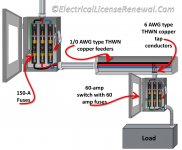hitehm
Member
- Location
- Las Vegas NV
It seems anytime you see images online of "feeder taps" like the example attached , they always show conductors physically tapped (spliced) onto feeder wires that have OCPD protection from the upstream source. But what if the feeders are connected straight off the MSP bus (using a lug kit or similar) with no OCPD protection at their source? Is this feeder now considered a feeder "tap" and subject to all the tap rules from 240.21B? It seems to possibly fit the definition of "Tap Conductor" in 240.2 but I'm not sure if this is actually considered a "tap"? I guess another way of asking is: Can a feeder be both a feeder and a feeder tap simultaneously by definition? I am dealing with this exact situation having feeders connected with lugs off the MSP and need to know how to size my wires.



